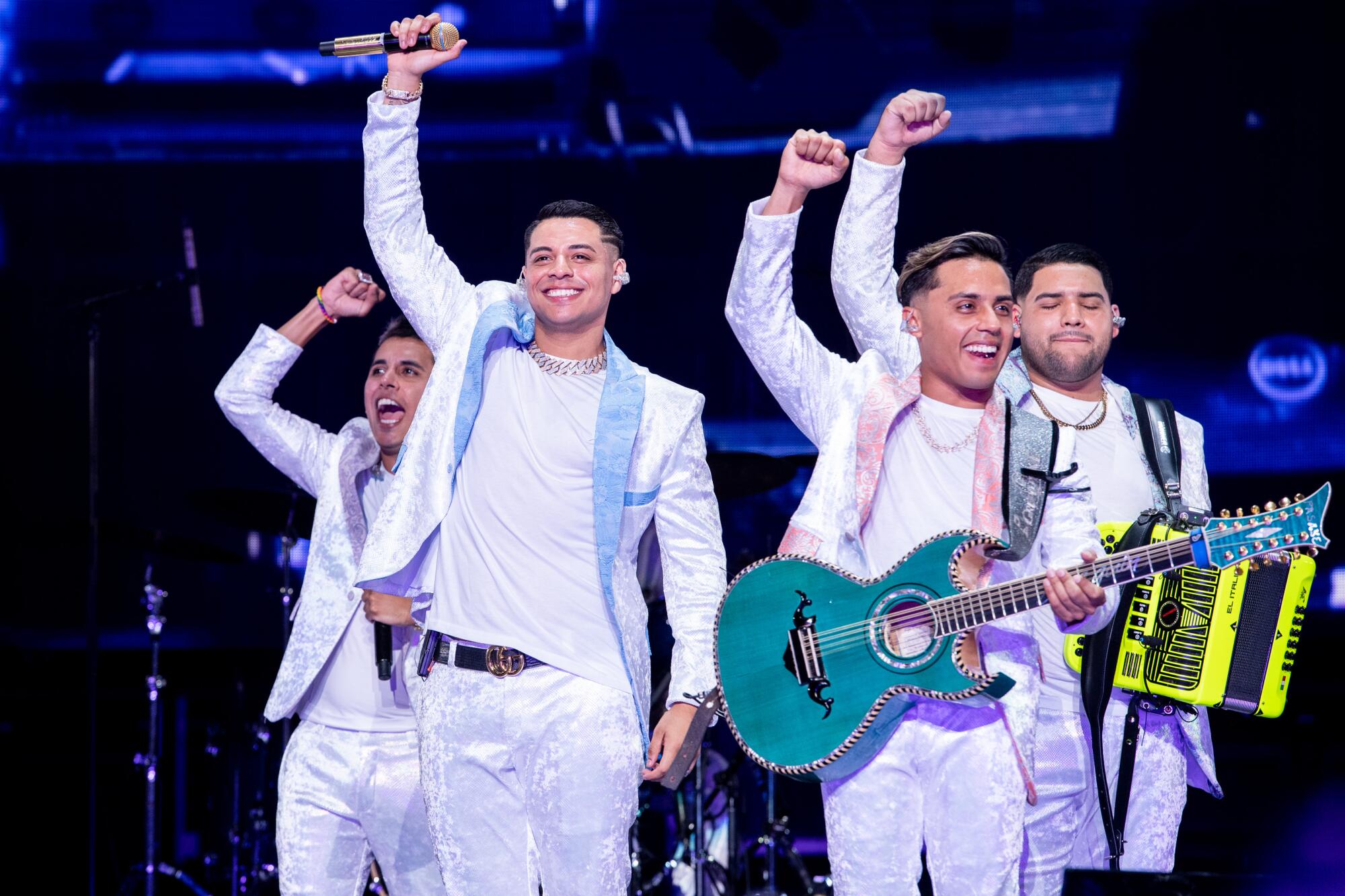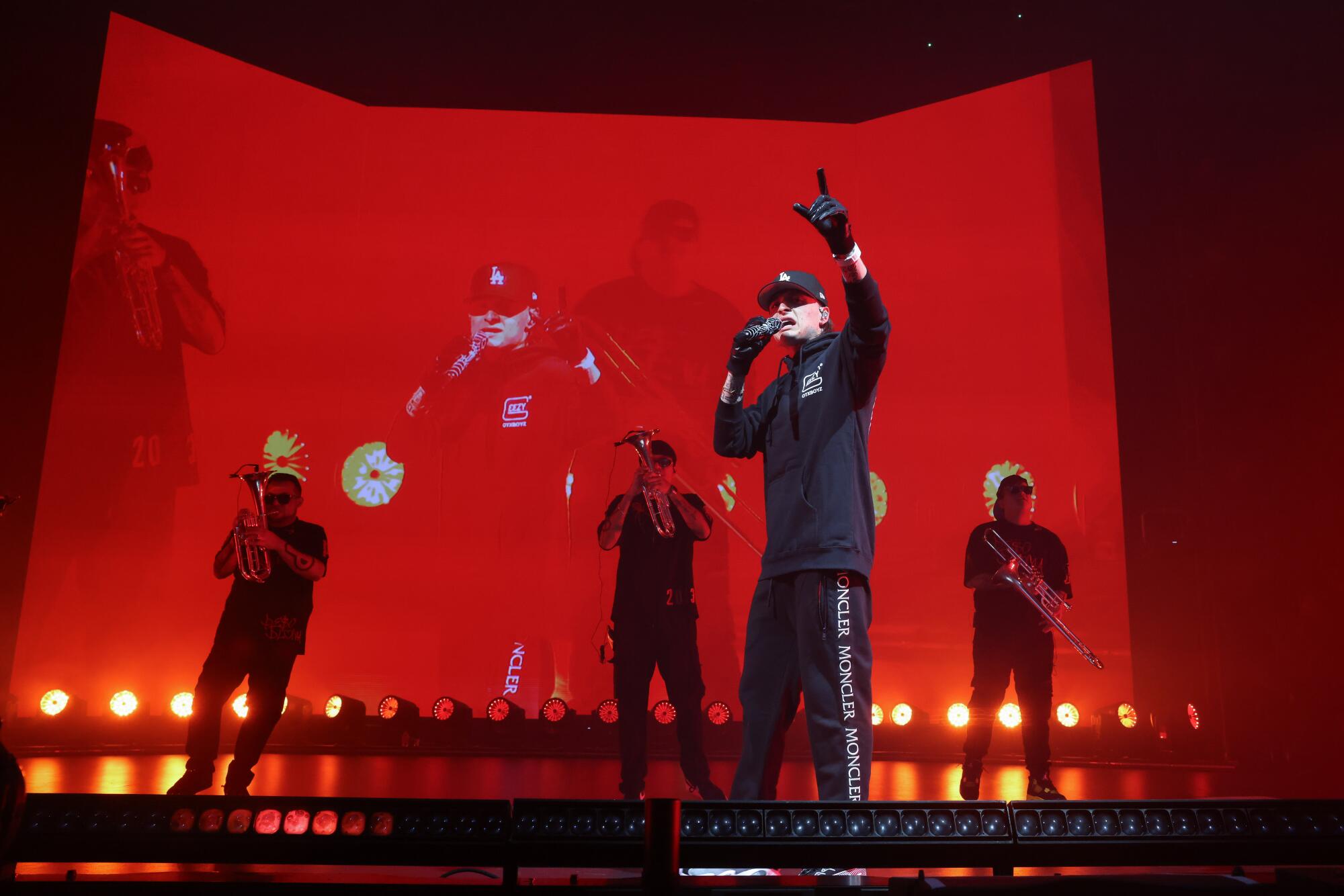During the final night of Grupo Firme’s 2021 stint of seven sold-out shows at what was then called Staples Center, frontman Eduin Caz launched into “En Tu Perra Vida” — “In Your Bitch Life” — by singing its chorus a capella.
Standing in the back and wearing matching white Dodgers-inspired jerseys that read “Gracías L.A.,” the rest of the septet waited for Caz to finish before joining in. The crowd exploded with cheers and applause.
“It was like a party happening onstage,” recalled Hallie Yavitch, senior vice president of booking operations and marketing for the now-renamed Crypto.com Arena and the nearby Peacock Theater and L.A. Live. “It was the best way to start our concert series back up after COVID.”

Members of Grupo Firme receive a declaration at Staples Center in July 2021.
(Timothy Norris/Getty Images)
Grupo Firme’s performances were among the first shows to take place in Los Angeles after pandemic restrictions were lifted, and they reflected not just post-COVID relief but the ongoing ascent of música Mexicana in the United States and across the globe. Los Angeles is playing a key role in the genre’s rise.
Yavitch said she had expected to book Grupo Firme for three shows, but those quickly sold out and four more concerts were added to meet the demand. The band from Tijuana drew nearly 80,000 fans to the arena and grossed a box office haul of $7 million. The group now holds the venue’s record for most performances by a Latin act in a single year and is only one show behind Adele’s record run at the venue during her “Adele Live 16” tour.
After the band’s 2021 success at Staples, Grupo Firme continued their run nationally, becoming the fifth-highest-grossing tour that year, raking in $167.7 million, according to trade publication Pollstar.
A 2022 report from the Recording Industry Assn. of America found that revenue from Latin music, which also includes reggaeton and salsa, exceeded $1 billion for the first time.
A Luminate report, released earlier this year, found that regional Mexican music is now the largest Latin subgenre in the U.S., and it’s also been one of the biggest drivers of growth for Latin music. A 2023 Spotify report shows that música Mexicana streams have grown worldwide by more than 440% in the past five years.
Los Angeles is a major market for the genre. According to the Pew Research Center, people of Mexican descent make up 75% of the region’s total Latino population, and almost half of the city’s residents are of Latino descent. A 2023 Luminate report found that 83% of U.S. regional Mexican listeners are Latino.
Since Grupo Firme’s record-setting run, other regional Mexican acts have played at Crypto.com and Peacock Theater, such as corridos tumbados singer Junior H, sad sierreño act Eslabon Armado and romantic balladeer Iván Cornejo. Yavitch estimates that one in five acts at these venues fall under the Latin music category.
Those artists, the executive said, also drive business to the adjacent L.A. Live area. After concerts, fans can continue their night at restaurants and bars — all services Yavitch markets.
Since the return of live entertainment, artists such as Los Bukis, Peso Pluma and Junior H, among others, have looked at L.A. as a key stop, according to Eddie Orjuela, a veteran Latin music booker with national live event promotion firm Nederlander Concerts. He adds that streaming also fuels attendance and venues have seen an uptick in ticket sales for música Mexicana acts.

Peso Pluma plays at YouTube Theater in July 2023.
(Dania Maxwell/Los Angeles Times)
Artists and venues are seeing bigger payouts, according to Orjuela. Venues also benefit from sales of alcohol, food, merchandise, parking fees and other concert-related expenses.
“The money is there,” Orjuela said. “It becomes, really, a win-win situation for the venue, for the artist, for the promoter, for the manager.”
The Latin Grammy-nominated group Los Bukis, led by returning co-founder Marco Antonio Solis, also took advantage of a post-pandemic return to L.A. as the first Latin act to sell out SoFi Stadium. According to Pollstar data, their two dates at the stadium trailed only a pair of stints by the Rolling Stones (at SoFi and Las Vegas’ Allegiant Stadium) as the third-highest-earning concert nationally in 2021, bringing in more than $13 million in revenue.
Adolfo Romero, vice president of event booking and revenue generation at SoFi Stadium and YouTube Theater, wasn’t surprised by the Los Bukis feat.
“Obviously it is a for-profit business, so we worked to identify those key areas of the business that make sense,” Romero said, adding that one-third of the show bookings at the two venues are Latin acts. “But ultimately, how we make our decisions is whether or not it makes sense for the [L.A.] community.”

Los Bukis frontman and co-founder Marco Antonio Solis plays at the Los Angeles Coliseum in August 2022.
(Raul Roa/Los Angeles Times)
Acts such as cumbia group Los Ángeles Azules, ballad singer Ana Bárbara and corridos tumbados phenom Peso Pluma also have benefited from the genre’s explosive growth and played shows at YouTube Theater, the 6,000-seat venue adjacent to SoFi. These concerts attract a diverse audience of multigenerational concertgoers, Romero said.
Promoters and bookers like Orjuela are seeing interest in música Mexicana shows outside of L.A. as well, from the Inland Empire to Orange County. Acts can earn large incomes as long as the shows are spread out enough within the three regions, Orjuela said. Fuerza Regida is a prime example, he adds, as the San Bernardino-based group traveled to neighboring city Ontario and sold out the Toyota Arena, an 11,000-seat venue.
Other artists, such as Los Tigres del Norte, have performed in the Inland Empire region, and tickets for a November show for Banda MS are set to soon go on sale for the Toyota Arena.
“L.A. is the melting pot of regional Mexican music,” Orjuela said, adding that promoters across the country track L.A. shows as a guide for booking. “If they do well here, the acts know that they have a greater chance of now going to other markets.”


